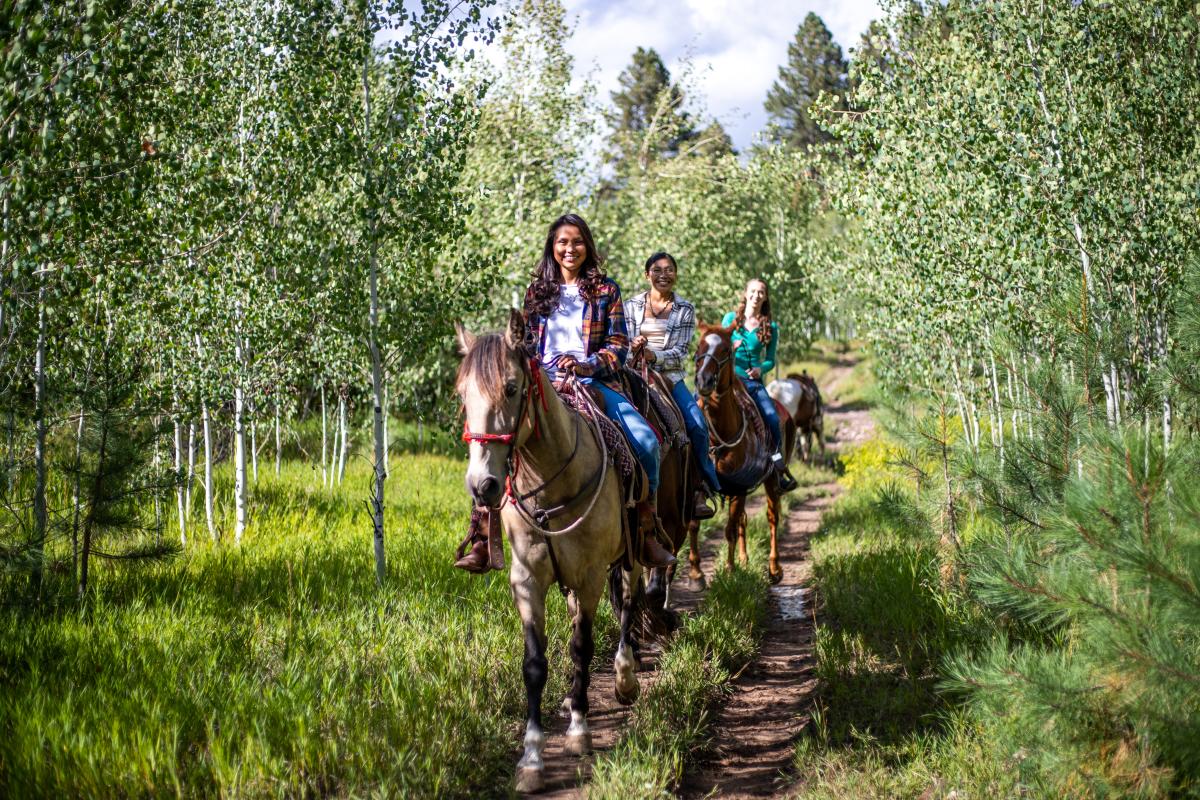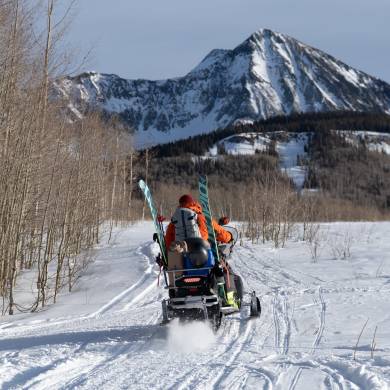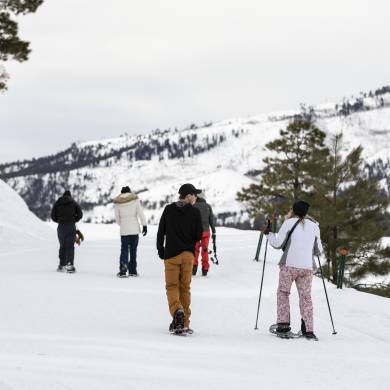- Home
- Places to Go
- Downtown
- Lakes
- Mountains
- Museums
- National Parks and Monuments
- Rivers
- State and Local Parks
- Trail Systems
- Wilderness Areas and Forests
- Home
- Things To Do
- Agritourism and Farms
- Arts
- Attractions
- Family Friendly
- Guides
- Health, Spas, and Wellness
- Outdoor Adventure
- Scenic Drives
- Shopping
- Home
- Lodging
- Bed and Breakfasts
- Cabins
- Campgrounds and RV Parks
- Hotels and Motels
- Lodges
- Vacation Rentals
- Home
- Eat
- Bars, Distilleries, and Wine
- Breakfast and Brunch
- Breweries and Grills
- Casual and Family-Friendly Dining
- Coffee and Tea Shops
- Farm-to-Table
- Fine Dining Options
- Food Trucks
- International Dining
Horseback Riding in Durango
Horseriding itself is an ancient practice that continues to capture the imagination of adventurers, old and young. For 5,500 years, humans have partnered with horses for food, transportation, and good ole’ fashioned fun. In our mountain town of Durango, the horseriding culture here has roots that go as far back as the 1600s.
Indeed, one can hardly picture the American Southwest without horses. To that end, many nearby trails are horse-accessible and provide boundless opportunities to take your mount into the beauty of our public lands. Because horses are cold-tolerant, horseback riding is also a year-round activity that you can engage in.
Durango is also a unique horseback riding destination because of its geographic location. Here, you can ride through alpine meadows, high deserts, and mountain slopes—all within 50 miles of town. Don’t take our word for it, though: saddle up and see why Durango will be your horse’s new favorite place to gallop.
Places to Go Horseback Riding
Near Durango, several horse-accessible trails are in the mid-country, high-country, and surrounding areas. However, taking your horse on trails in town is not recommended. Many horses fear traffic like mountain bikes, e-bikes, and fast-moving pedestrians. You should exercise caution when taking your mount onto popular multi-use trails.
Mid-Country

In the mid-country near Durango, equestrians can find many routes to take their trusty steeds. Just below the treeline, the mid-country offers creased protection from the elements and elevated views relative to the low-country.
Hermosa Area Trail Systems
34 miles north of Durango, the Hermosa Area trail system is a series of 14 mainly dirt routes spanning 105 miles. This system is open to equestrians year-round and can be accessed from Lower or Upper Hermosa Creek.
Depending on your chosen starting point, the trails here can gain or lose 1,500 feet of elevation. However, even the descents on this trail will still gain height in certain sections.
The courses on this system are known to be moderately difficult for horseriders. Be advised that the Hope Creek part of this system was heavily altered by the 416 fire in 2018, and there may still be debris in the area.
Vallecito and Lemon Reservoir Trail Systems
Both the Vallecito and Lemon Reservoir trail systems have something to offer horseriders of all abilities. Either approach can provide a quiet riding experience, far from the noise of cities and towns. You’ll be treated to spectacular views of some of the highest-altitude reservoirs in Colorado.
The Vallecito trail system is located about 18 miles northeast of Durango, with six horse-accessible routes to traverse. Starting from the reservoir, most of these trails have a steep 1,000-foot increase in elevation up dirt and rock paths but are easy for most horses.
Two miles to the west, the Lemon Reservoir trail system has just one horse-accessible route: Youngs Canyon Trail. It gains about 2,000 feet of elevation up rocky paths in 4.5 miles and is particularly difficult for some horses.
High-Country
In the high country, you’ll be spoiled by the towering views of the mountain valleys below. You can take to these majestic slopes from your horse in a way you might not be able to on foot. Exercise caution when bringing your mount deep into the backcountry, however.
Coal Bank and Molas Pass Trail Systems
In the Coal Bank and Molas Pass trail systems, there are only three feasible trails for horseriding: Little Molas Lake Trail, Engineer Mountain Trail, and Crater Lake Trail. These routes are located just off U.S. Highway 550, are dirt singletracks, and don’t gain much elevation.
Haviland Lake Trail Systems
The Haviland Lake trail system is a local favorite comprised of 11 trails spanning 9 miles. If you don’t mind the company, it is frequented by equestrians, hikers, and wildlife enthusiasts. The system is about 20 miles north of Durango, and the trails can all be explored within one day. It is open to horseriders year-round and has gentle grades perfect for older mounts.
Surrounding Areas
Though there are plenty of horse-accessible trails in Durango's immediate vicinity, you may want to branch out and explore different environments. Here’s the good news: you’re in luck, as several neighboring regions have more opportunities for horseriding. There is no bad news.
Cortez and Mancos Systems
If you’re looking for powdery high-desert fun, look near Cortez or Mancos, Colorado. Both regions have drier and flatter conditions than Durango’s trail networks. This can be especially useful to know if you have elderly horses needing solid exercise.
Near Cortez, 46 miles from Durango, these are the four most popular trails for horses: the 2.5-mile Highline Loop, the 6.3-mile Sand Canyon trail, the 4.25-mile Chutes & Ladders trail, and the 1.5-mile Doc Sarvis - Lower trail. None of the routes listed here are challenging, as they each gain only 200 feet in elevation on easy dirt singletracks.
28 miles west of Durango, equestrians can also find some quality horseback riding trails at the Chicken Creek System near Mancos, Colorado. Here, there are 15.2 miles to discover with a slightly heftier elevation gain of 750 feet, primarily up gravel and dirt.
Dolores Trail Systems
About 50 miles west of Durango, equestrians can find the 62-mile Boggy Draw trail system near Dolores, Colorado. This trail system is for horse riders seeking a long, leisurely ride on red dirt through ponderosa pine, oak brush, and open prairies. The Boggy Draw trail system gains about 775 feet from base to top slowly.
As you ride in this system, you may find that many herds of cattle graze in the summer. The Boggy Draw trail network was built by old-school ranchers connecting cow paths
Silverton Trail Systems
Drive 47 miles north of Durango. You’ll find a classic network of horse-accessible trails just outside Silverton, a beautiful ex-mining town with jaw-dropping views. The horseriding trails here are tough on mounts with their steep elevation gain and rocky trail composition. You’ll find seven trails to explore in the immediate area, ranging from daylong to monthlong trips.
If you’re looking for the former, check out the 2.4-mile Swansea Gulch Trail or the 6.3-mile Boulder Gulch Trail.
If you’re looking for the latter, take the 2.9-mile Little Giant Peak Trail to connect with the Highland Mary Lake trailhead. From here, you can hook up with the 740-mile Continental Divide Trail or the 486-mile Colorado Trail.
Things to Know About Horseback Riding in Durango
-
Do not tie your horses to trees or shrubs. Instead, horses should be tied to a hitching post or horse trailer.
-
If you don’t own a steed, fret not! You can visit the Colorado Trails Ranch, where they offer guided rides from professional equestrians.
-
It is best to go horseriding on weekdays to avoid other trail traffic.
-
Because of the high elevation in Durango, expect to ride no more than 10 to 20 miles in one day.
-
Should your horse die, it is your responsibility to remove it from the trail.
-
You can find data on current trail conditions for Durango-based routes here.
Care for Durango
-
To minimize erosion avoid riding on wet or soft trails.
-
Purchase a CORSAR card before going out into the backcountry.
-
Follow Leave No Trace (LNT) principles.
-
Do not engage with or feed the wildlife.
-
Practice proper trail etiquette.


